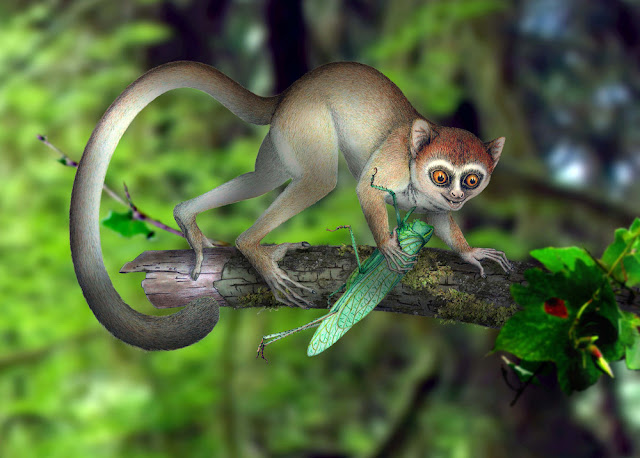Oldest primate-Archicebus achilles
Oldest primate-Archicebus achilles
Chinese Academy of Sciences shows a reconstruction of Archicebus achilles in its natural habitat of trees. One of our earliest primate relatives was a hyperactive wide-eyed creature so small you could fit a few of them in your hand, if they would just stay still long enough, new fossil evidence shows.
An international team of researchers has announced the discovery of the world’s oldest known fossil primate skeleton, an animal that lived about 55 million years ago and was even smaller than today’s smallest primate, the pygmy mouse lemur. The new specimen, named Archicebus achilles, was unearthed from an ancient lake bed in central China’s Hubei Province, near the course of the modern Yangtze River. In addition to being the oldest known example of an early primate skeleton, this almost complete new fossil is crucial for illuminating a pivotal event in primate and human evolution: the divergence between the lineage leading to modern monkeys, apes, and humans (collectively known as anthropoids) and the branch leading to living tarsiers small, nocturnal tree-dwelling primates. The discovery, described today in the journal Nature, also provides evidence that the earliest primates were active during the day, climbed trees, and primarily ate insects.
“Archicebus marks the first time that we have a reasonably complete picture of a primate close to the divergence between tarsiers and anthropoids,” said lead researcher Xijun Ni, a scientist at the Institute of Vertebrate Paleontology and Paleoanthropology at the Chinese Academy of Sciences in Beijing and a research associate at the American Museum of Natural History. “It represents a big step forward in our efforts to chart the course of the earliest phases of primate and human evolution.”
The fossil was recovered from sedimentary rock strata that were deposited in an ancient lake roughly 55 million years ago, a time of global greenhouse conditions, when much of the world was shrouded in tropical rainforests and palm trees grew as far north as Alaska. Like most other fossils recovered from ancient lake strata, the skeleton of was found by splitting apart the thin layers of rock containing the fossil. As a result, the skeleton is now preserved in two complementary pieces, each of which contains elements of the actual skeleton as well as impressions of bones from the other side.


Comments
Post a Comment